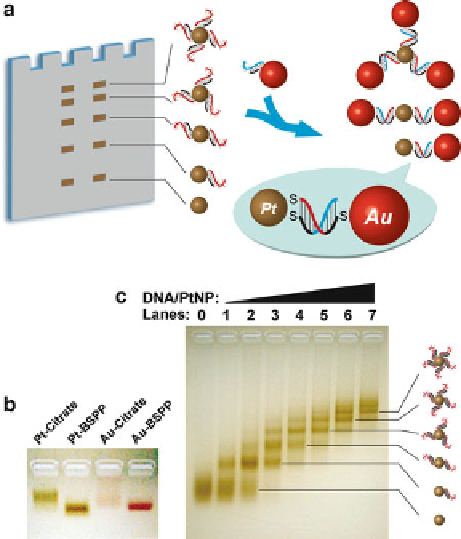Biomedical Engineering Reference
In-Depth Information
Fig. 8.13
Gel electrophoretic
separation of
DNA-conjugated platinum
nanoparticles with specific
DNA bonding valences as a
new building block for
DNA-directed self-assembly
(Reproduced from Ref. [
38
]
by permission of The Royal
Society of Chemistry)
interesting due to their catalytic activities, a further investigation of the coupled
plasmonic-catalytic properties of the resulting Au-Pt heteronanostructures as well
as the use of them in biosensors and catalytic nanomotors would be worthwhile.
Our work clearly demonstrated that Pt nanoparticle is the second example of a metal
nanomaterial for which discrete DNA decorations can be realized. From now on,
the dominating role of gold nanoparticles in DNA-programmed nanomaterials can
have a change.
Although the similarity between gold and silver nanoparticles (AgNPs) has long
been recognized, achieving a stable DNA decoration of AgNPs has never been as
successful as the gold nanoparticles. Considering the relatively weak chemical,
colloidal, and Ag-thiol bonding stabilities of AgNPs in comparison with gold
nanoparticles, special procedures and carefulness are needed during their DNA
functionalizations, including the use of a thin layer of gold plating [
64
], a stronger
cyclic disulfide anchoring group [
65
], and a phosphorothioate oligonucleotide
[
40
]. As well, surfactants are often needed to accompany the silver nanoparticles
to achieve an enhanced salt resistance of the colloidal particles during a DNA
decoration experiment [
66
], which, however, will cause problems regarding their
chemical and biological compatibilities. Also, the lack of a simple method to
generate silver nanoparticles with a uniform size and a suitable surface charge
added extra obstacles during a gel electrophoretic separation of DNA-conjugated
AgNPs.

Search WWH ::

Custom Search